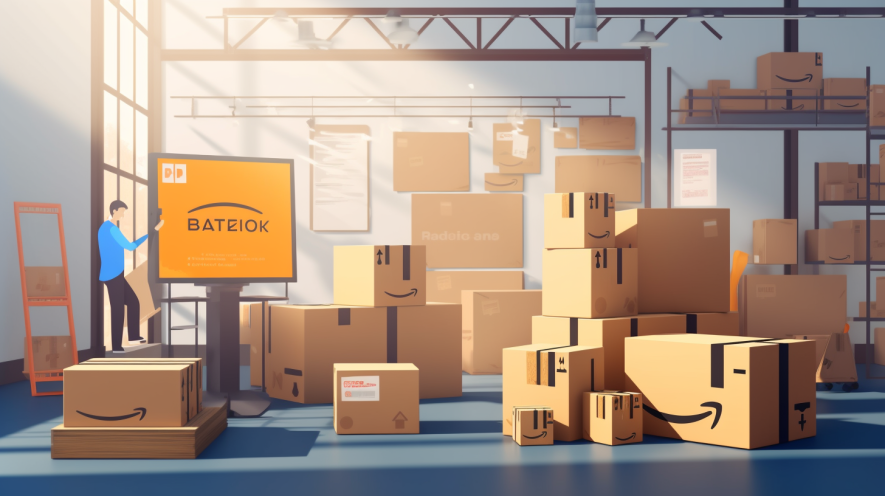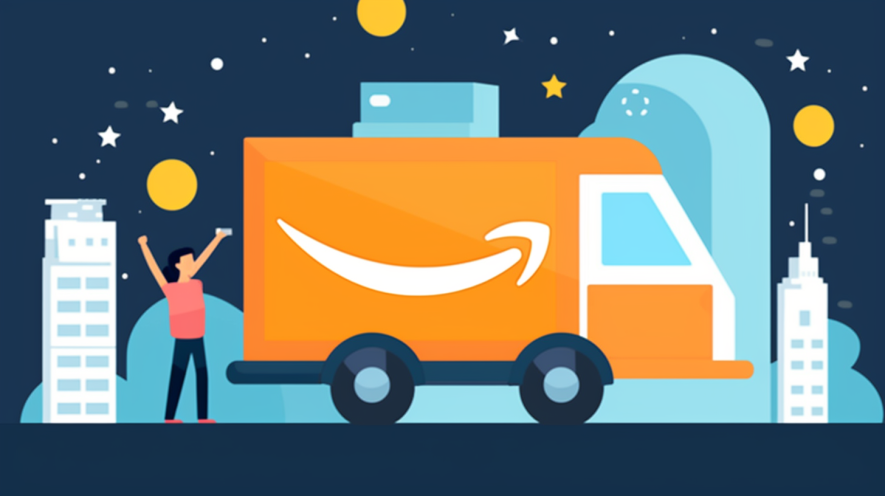Learn essential strategies for efficient Amazon inventory importing & delivery to optimize your business & delight customers.
Efficient inventory shipping plays a crucial role in the success of businesses operating on Amazon, as it directly impacts both customer satisfaction and overall business performance. With the ever-increasing demand for fast and reliable delivery, ensuring seamless importing and timely shipping of inventory has become paramount.
By mastering the art of efficient inventory shipping, sellers can not only meet customer expectations but also gain a competitive edge in the highly saturated Amazon marketplace.
This article delves into various strategies that businesses can employ to optimize their inventory shipping processes, ultimately leading to enhanced customer satisfaction and increased business success.
So, if you’re ready to streamline your inventory shipping processes and overcome unexpected challenges, let’s dive in and master the art of Amazon inventory shipping together!
Key Areas to Take Note on Amazon’s Inventory Management System
You need to pay close attention to Amazon’s Inventory Management System if you want to master efficient importing and delivery – it’s the key to staying ahead of the competition and maximizing your profits.
Amazon’s Inventory Management System provides crucial tools for inventory tracking, supply chain management, and inventory optimization.
With inventory tracking, you can monitor your stock levels in real-time, ensuring that you never run out of popular items and minimizing the risk of overselling.
The system also allows you to streamline your supply chain management by automating reorder processes and identifying potential bottlenecks.
Furthermore, inventory optimization features help you analyze sales trends and forecast future demand, enabling you to make informed decisions about product quantities and storage needs.
By utilizing Amazon’s Inventory Management System effectively, you can ensure smooth importing and delivery processes, leading to improved customer satisfaction and increased sales.
Understanding Amazon’s Inventory Management System
FBA vs. FBM: Pros and Cons
When deciding between FBA (Fulfillment by Amazon) and FBM (Fulfillment by Merchant), it’s important to consider various factors.
Pricing is one key area to compare. With FBA, you’ll have to pay for storage and fulfillment fees, but you can often charge higher prices due to the Prime badge and faster shipping.
FBM, on the other hand, allows you to have more control over pricing, but you’ll need to handle all aspects of fulfillment yourself.
Another aspect to consider is customer reviews. FBA sellers tend to receive more positive reviews because of the reliable and fast shipping.
Lastly, seller feedback is typically better for FBA sellers as they have less control over the shipping and handling process.
Ultimately, it’s crucial to weigh the pros and cons of FBA and FBM to determine which option is best for your business.
Inventory Performance Index (IPI) and Its Significance
The IPI is a vital metric that measures your inventory’s overall health and efficiency. It takes into account factors such as excess inventory, sell-through rate, and stranded inventory.
By monitoring and optimizing your IPI, you can ensure that your inventory is always in sync with customer demand. This leads to improved shipping efficiency and reduced storage fees.
Additionally, the IPI can help you navigate import regulations and avoid costly delays.
By maintaining a high IPI score, you demonstrate to Amazon that you are a reliable seller with a strong inventory management system.
Best Practices for Managing Inventory Levels
Managing inventory levels on Amazon requires a strategic approach to ensure products are consistently available for customers while avoiding excess stock that ties up capital and storage space.
Here are some best practices for managing inventory on Amazon:
- Use Amazon’s Fulfillment Services: Utilize Amazon’s Fulfillment by Amazon (FBA) service to store, pack, and ship your products. FBA allows for faster shipping and access to Prime customers, enhancing the customer experience.
- Keep Adequate Stock Levels: Regularly monitor sales velocity and use historical data to forecast demand. Maintain sufficient stock levels to avoid stockouts and take advantage of increased sales during peak periods.
- Set Replenishment Triggers: Determine reorder points based on lead time, sales velocity, and seasonality. Set up automated replenishment triggers to ensure timely reordering.
- Monitor Sell-Through Rate: Track the sell-through rate (the rate at which inventory sells) to identify slow-moving items. Consider offering promotions or bundling to improve sales for these products.
- Implement Seasonal Planning: Analyze seasonal trends and plan inventory levels accordingly. Adjust stock levels for products with fluctuating demand during peak seasons.
- Use Amazon’s Inventory Performance Index (IPI): The IPI is a score that Amazon uses to evaluate your inventory management efficiency. Aim to keep your IPI above 450 to avoid storage limits and long-term storage fees.
- Analyze Amazon’s Storage Fees: Understand Amazon’s storage fee structure and identify products that incur higher fees due to their size or storage duration. Optimize your inventory mix to minimize storage costs.
- Manage Excess Inventory: If you have excess stock, consider running promotions or sponsored ads to boost sales. Alternatively, create bundles with slow-moving items to increase their appeal.
- Monitor Lead Times: Keep track of your suppliers’ lead times and factor them into your inventory planning. Account for any delays to avoid running out of stock during crucial periods.
- Utilize Sales and Inventory Reports: Use Amazon’s sales and inventory reports to gain insights into product performance and inventory health. Leverage this data to make informed decisions.
- Implement Amazon’s Forecasting Tools: Amazon offers tools like “Manage Excess Inventory” and “Inventory Performance Dashboard” to assist with inventory planning and identify opportunities for improvement.
- Optimize Product Listings: Ensure your product listings are accurate and attractive to customers. Well-optimized listings can lead to higher conversion rates and increased sales.
- Monitor Competitor Activity: Keep an eye on competitor pricing and promotions to adjust your inventory strategy accordingly. Price competitively to maintain sales momentum.
- Consider Bundling and Multi-Packs: Create bundles or multi-packs of complementary products to increase average order value and move inventory faster.
Sourcing and Importing Inventory
Selecting Reliable Suppliers and Manufacturers
To select reliable suppliers and manufacturers, it’s important to:
- Do thorough research and vetting
- Look for suppliers with a proven track record of delivering on time and meeting quality standards
- Check reviews and ratings
- Consider getting samples to test product quality
When considering manufacturers, it’s important to:
- Look for manufacturers with a strong reputation in the industry
- Consider their experience producing the types of products you need
Efficient importing is crucial, so consider:
- Working with suppliers experienced in international shipping
- Suppliers who can provide necessary documentation and support
Choosing the Right Shipping Methods and Carriers
Now that you have selected reliable suppliers and manufacturers for your Amazon inventory, it’s time to dive into the next crucial aspect of efficient importing and delivery: choosing the right shipping methods and carriers.
This step is vital to ensure that your products reach your customers in a timely and cost-effective manner.
When it comes to shipping optimization, it’s important to consider both domestic and international shipping options.
For international shipping, freight forwarding can be a great solution, as it helps streamline the process by managing the logistics and paperwork involved in shipping goods across borders. By utilizing freight forwarding services, you can save time and effort while ensuring smooth and efficient delivery of your inventory.
When choosing carriers, consider factors such as cost, reliability, and transit time to select the best option for your specific needs.
Navigating Customs and Import Regulations
To help you navigate this intricate path, here are four essential tips:
- Understand customs clearance: Familiarize yourself with the customs clearance process. This involves submitting the necessary documents and paying any applicable import duties or taxes. By understanding this process, you can ensure the smooth passage of your goods through customs.
- Research import duties: Each country has its own import duty rates, which vary depending on the type of product. It is important to research and factor these costs into your pricing strategy to avoid any surprises.
- Gather import documentation: Collect all the required import documentation, such as commercial invoices, packing lists, and certificates of origin. Having these documents ready and accurate will expedite the customs clearance process.
- Consult with experts: If you are unsure about any aspect of customs and import regulations, seek guidance from professionals or experienced importers who can provide valuable insights and advice.
Inventory Preparation and Packaging
By taking the time to exert extra effort in inventory preparation and packaging, you can minimize the risk of damaged or lost goods, prevent delays, and ensure that your products arrive in excellent condition to your customers.
Amazon’s Packaging Requirements and Guidelines
Effective packaging is an essential aspect of inventory management that can help protect your products and maintain customer satisfaction.
To help you navigate this process, here are three essential packaging guidelines to keep in mind:
- Use sturdy materials: Amazon requires that your packaging is strong enough to withstand transportation. Opt for corrugated boxes that are at least 32 ECT (Edge Crush Test) for standard-size items, and 44 ECT for heavy or large items. Reinforce the corners and seams with tape for added durability.
- Minimize empty space: Fill any empty gaps in your packaging with cushioning materials like bubble wrap or air pillows. This prevents your items from shifting during transit and reduces the risk of damage.
- Label correctly: Amazon has specific labeling requirements for both the shipping label and the product label. Make sure you follow these guidelines accurately to avoid any delays or complications.
Using Efficient Labeling and Barcoding Systems
Labeling and barcoding systems are essential for streamlining your inventory management process and ensuring accurate tracking of your products. Efficient inventory tracking is crucial for successful importing and delivery on Amazon.
By implementing a reliable labeling system, you can easily identify and organize your products, minimizing errors and saving time.
When it comes to barcoding, the benefits are numerous. Barcode scanning allows for quick and accurate data entry, reducing the risk of human error. It also enables faster and more efficient inventory counts, making it easier to keep track of stock levels.
To ensure optimal results, it is important to follow labeling best practices. This includes placing labels in a visible and easily scannable location, using high-quality barcode labels, and regularly auditing your labeling system to identify and address any issues.
Ensuring Product Protection During Transit
Proper product packaging is crucial to avoid any damage or loss. Here are three essential strategies to consider:
- Choose sturdy packaging materials: Opt for high-quality boxes, bubble wrap, and packing peanuts to provide cushioning and protect your products from any impact during transportation.
- Invest in transit insurance: Accidents can happen, and having transit insurance will give you peace of mind, knowing that you’re financially protected in case of any mishaps or damages during transit.
- Train your staff on proper product handling: Educate your team on the importance of careful handling and provide them with guidelines to follow when packing and loading products. This will minimize the risk of any mishandling that could result in damage.
Streamlining Shipping Processes
Implementing Efficient Order Processing Systems
Implementing efficient order processing systems is crucial for enhancing operational efficiency and ensuring seamless management of orders across multiple channels. Automating manual tasks such as order entry, inventory management, and shipping label generation can save time and reduce the risk of errors and delays.
Integrating a centralized system with your supply chain provides real-time visibility into inventory levels, allowing you to optimize stock levels and avoid stockouts. This streamlining of order processing not only improves customer satisfaction but also reduces costs and boosts overall productivity.
Leveraging Fulfillment Centers and Third-Party Logistics (3PL) Services
Fulfillment centers can provide automation solutions that streamline your inventory shipping process. By utilizing fulfillment center automation, you can reduce errors and increase efficiency, ultimately improving customer satisfaction.
Additionally, partnering with a third-party logistics (3PL) provider can offer benefits such as cost savings and scalability. Conduct a thorough 3PL cost analysis to determine the most cost-effective solution for your business. This analysis should consider factors such as shipping rates, storage fees, and additional services provided.
Another important aspect of optimizing your order fulfillment is inventory tracking. Implementing an inventory tracking optimization system allows you to monitor stock levels in real-time, ensuring accurate and timely order fulfillment.
Strategies for Minimizing Shipping Costs
Minimizing shipping expenses is crucial for maintaining a cost-effective operation.
One effective strategy is to utilize lightweight packaging materials that still provide adequate protection for your products. By reducing the weight of each package, you can significantly lower transportation costs.
Another strategy is to optimize the dimensions of your packages to minimize wasted space and maximize the number of units that can be shipped in a single shipment. This can be achieved by using custom-sized boxes or by utilizing packaging solutions that can be easily adjusted to fit various product sizes.
Additionally, negotiate shipping rates with your carriers and explore alternative shipping options to find the most cost-effective solution for your business.
Delivery Strategies for Customer Satisfaction
Amazon Prime and Its Impact on Customer Expectations
Despite the rise of Amazon Prime and its ability to offer fast and convenient shipping, some customers still harbor outdated expectations for delivery times.
It is important for sellers to understand that Amazon Prime has set a new standard for delivery speed, and customers now expect their packages to arrive within two days or even less.
To meet these expectations and maintain customer loyalty, it is crucial to prioritize efficient shipping processes. This includes investing in reliable shipping carriers, utilizing fulfillment centers strategically located near customer hubs, and optimizing packaging to ensure product protection and presentation.
By focusing on these areas, sellers can not only meet customer expectations but also exceed them, building a reputation for exceptional delivery speed and packaging quality that will enhance customer satisfaction and drive repeat business.
Fast and Reliable Shipping Options
To prioritize fast and reliable shipping options, there are a few key factors to consider:
- Investing in reliable shipping carriers is essential.
Look for carriers with a proven track record of timely deliveries and excellent customer service. Working with reputable carriers can ensure that your packages are delivered quickly and efficiently.
- Consider utilizing expedited shipping methods for urgent orders.
Express shipping or overnight delivery options can significantly reduce delivery times, ensuring that your customers receive their orders as quickly as possible.
- Establish fulfillment centers near customer hubs.
By strategically locating your fulfillment centers, you can reduce transit times and expedite the processing and shipping of orders. This can lead to quicker delivery times and increased customer satisfaction.
Handling Returns and Customer Inquiries
Handling returns requires a streamlined process that starts with clear and easy-to-understand return policies. Clearly communicate these policies to your customers, and provide them with a hassle-free return process. This will help build trust and loyalty among your customer base.
When it comes to customer inquiries, prompt and helpful responses are key. Respond to inquiries in a timely manner, and ensure that your customer support team is well-trained and knowledgeable about your products and policies. Utilize tools like chatbots and email templates to streamline your responses and provide consistent and accurate information.
Utilizing Amazon’s Shipping Services
Benefits of Using Amazon’s FBA Program
Utilizing Amazon’s FBA program offers a multitude of advantages that will leave you feeling empowered and relieved. Here are three key benefits to consider:
- Improving efficiency: By using Amazon’s FBA program, you can streamline your inventory management and shipping processes. Amazon takes care of the warehousing, packing, and shipping for you, allowing you to focus on other aspects of your business. This saves you time and effort, ultimately improving your overall efficiency.
- Cost savings: With FBA, you can take advantage of Amazon’s extensive network of fulfillment centers. This means you can store your inventory closer to your customers, reducing shipping costs and delivery times. Additionally, Amazon’s bulk shipping rates are often more cost-effective than individual shipments, resulting in potential cost savings for your business.
- Customer satisfaction: Amazon’s FBA program ensures fast and reliable shipping, which leads to increased customer satisfaction. With Amazon handling the logistics, your customers can expect quicker delivery times and reliable tracking information. This not only enhances their shopping experience but also boosts your seller reputation on the platform.
FBA Best Practices for Improved Shipping Performance
Improving shipping performance with Amazon’s Fulfillment by Amazon (FBA) service is crucial for ensuring customer satisfaction and winning the coveted Prime badge.
Here are some FBA best practices to enhance shipping performance:
- Maintain Sufficient Stock Levels: Ensure you have an appropriate quantity of inventory at Amazon’s fulfillment centers to avoid stockouts and maintain fast shipping times.
- Use FBA’s Inventory Placement Service (optional): If you choose to enable this service, Amazon will distribute your inventory across multiple fulfillment centers strategically, which can reduce shipping times for customers.
- Monitor Inventory Health: Regularly check your inventory health metrics, such as stranded inventory and excess inventory, to address any issues promptly.
- Leverage Amazon’s Shipping Templates: Create shipping templates to specify shipping options and settings for different products. This ensures consistency and reduces errors in shipping settings.
- Use Amazon’s Box Content Information (BCI) Tool: When shipping multiple units of the same product to Amazon, use the BCI tool to provide detailed information about the contents of each box. This helps in accurate receiving and faster processing.
- Optimize Product Packaging: Ensure your products are well-packaged and comply with Amazon’s packaging guidelines to prevent damage during transit and reduce the likelihood of returns.
- Set Realistic Handling Time: Set accurate handling times for your products. Longer handling times may affect your Buy Box eligibility and lead to slower shipping times.
8. Utilize FBA’s Free Shipping Option: Offer free shipping for products eligible for Prime to attract more customers and improve conversion rates.
- Monitor FBA Order Cut-Off Times: Be aware of FBA order cut-off times to ensure timely shipment of orders. This information is available in your seller account.
- Regularly Replenish Inventory: Keep an eye on your inventory levels and initiate timely restocking to avoid running out of stock.
- Utilize FBA Small and Light (optional): For smaller, lightweight items, consider enrolling in the FBA Small and Light program to reduce fulfillment costs and offer faster shipping for eligible products.
- Enable Premium Shipping Options: Consider enabling premium shipping options like Two-Day Delivery or One-Day Delivery if your products qualify. This can attract more Prime customers and improve sales.
- Respond to Customer Messages Promptly: Timely responses to customer inquiries can help address shipping-related concerns and prevent negative feedback.
- Track and Trace Shipments: Use Amazon’s shipment tracking and carrier services to monitor the delivery status of your orders.
- Monitor Customer Feedback: Keep a close eye on customer feedback related to shipping and take appropriate actions to address any issues.
Evaluating FBA Vs. FBM for Different Products
To make a more informed decision, consider evaluating whether FBA or FBM is the best option for your different products. Take into account factors such as product size and fragility, as well as your own storage and fulfillment capabilities.
When it comes to pricing strategies, FBA can give you an advantage with its Prime eligibility. This allows you to set higher prices for your products. On the other hand, FBM gives you more control over pricing. It allows for more flexibility and the ability to adjust prices quickly.
In terms of marketing tactics, FBA offers the benefit of increased visibility and trust from customers due to the Prime badge. FBM, however, allows you to include branded packaging and promotional materials. This gives you the opportunity to create a more personalized experience for your customers.
Lastly, when it comes to customer segmentation, FBA is ideal for targeting Prime members. Prime members tend to be more loyal and make frequent purchases. FBM, on the other hand, allows you to cater to a wider range of customers, including those who are not Prime members.
Monitoring and Optimizing Shipping Performance
Closely tracking your shipping performance can help you to identify areas for improvement and take action to enhance your overall operations.
Here are three key reasons why monitoring and optimizing shipping performance is crucial:
- Benefits of monitoring shipping performance: Regularly assessing your shipping performance allows you to identify any bottlenecks or inefficiencies in your supply chain. This enables you to make necessary adjustments and streamline your operations, leading to cost savings and improved productivity.
- Impact of shipping delays: Shipping delays can have a significant negative impact on your business, resulting in dissatisfied customers, negative reviews, and loss of sales. By monitoring your shipping performance, you can proactively address any delays and minimize their impact on your business.
- Customer satisfaction with shipping performance: Timely and reliable shipping is crucial for customer satisfaction. By monitoring and optimizing your shipping performance, you can ensure that your customers receive their orders on time and in good condition. This not only enhances customer experience but also fosters positive reviews and repeat business.
Key Performance Indicators (KPIs) for Shipping Efficiency
Monitoring shipping metrics allows you to identify areas for improvement and implement strategies to enhance your shipping efficiency.
- On-time delivery rate
Measures the percentage of orders that are delivered within the promised timeframe. This metric helps you gauge the reliability of your shipping process and identify any potential bottlenecks.
- Order accuracy rate
Measures the percentage of orders that are shipped correctly and without errors. This metric helps ensure that your customers receive the correct products, reducing the need for returns and improving customer satisfaction.
- Average shipping cost per order
It can help you identify cost-saving opportunities and optimize your shipping strategy.
Tools and Software for Tracking Inventory and Shipments
Using tools and software is essential for effectively tracking and managing inventory and shipments.
When it comes to inventory tracking software, there are several options available that can streamline your operations. These software solutions allow you to easily monitor stock levels, track sales data, and generate reports for better decision-making.
Additionally, shipment tracking tools are crucial for keeping an eye on your packages as they make their way to your customers. These tools provide real-time updates on the status and location of each shipment, ensuring that you can address any issues promptly.
Lastly, inventory management systems offer a comprehensive solution for overseeing your entire inventory process. They integrate with various software and tools, allowing you to automate tasks, forecast demand, and optimize your inventory levels.
Continuously Improving Shipping Processes
To enhance your shipping processes, it is crucial to consistently refine and optimize your methods. Continuous improvement is key in ensuring that your supply chain is operating at its highest efficiency.
One way to achieve this is through supply chain optimization. By analyzing every step of your shipping process, from order placement to delivery, you can identify areas for improvement and implement strategies to streamline operations.
Additionally, shipping automation can greatly assist in improving efficiency. By automating repetitive tasks such as label printing and order tracking, you can save time and reduce errors. Utilizing software solutions that integrate with your inventory management system can further enhance your shipping processes.
Dealing with Unexpected Challenges
By proactively dealing with these challenges, you can ensure a more efficient and successful shipping process.
Inventory Stockouts and Overstock Situations
Despite meticulous planning, inventory stockouts and overstock situations can occur. To effectively handle these situations, it is crucial to implement inventory optimization strategies.
For inventory stockouts, it is important to have real-time visibility into your inventory levels. Set up automated alerts to notify you when stock is running low. Additionally, establish relationships with alternative suppliers to mitigate the impact of stockouts.
On the other hand, overstock situations can be managed by regularly analyzing sales data and forecasting demand accurately. Implementing a just-in-time inventory strategy can also help prevent overstock situations by ensuring that you have the right amount of inventory at the right time.
Shipping Delays and Disruptions
Ensure your customers receive their orders on time by effectively addressing shipping delays and disruptions.
To minimize shipping delays, consider implementing these strategies:
- Streamline your supply chain
Optimize your inventory management and order fulfillment processes to reduce bottlenecks and improve efficiency. This includes regularly reviewing and updating your shipping carriers and logistics partners to ensure they can meet your delivery timelines.
- Monitor and communicate
Keep a close eye on your shipments and proactively communicate any potential delays or disruptions to your customers. Utilize tracking tools and provide real-time updates to maintain transparency and manage expectations.
To address supply chain disruptions, follow these steps:
- Diversify your suppliers
Relying on a single supplier can leave you vulnerable to disruptions. Identify alternative suppliers and establish relationships with them to mitigate the impact of any unforeseen disruptions.
- Maintain safety stock
Have a buffer inventory in case of unexpected disruptions. This helps ensure you have enough stock to fulfill orders even during challenging times.
Customer Complaints and Negative Feedback
Resolving customer complaints and negative feedback can be challenging. However, addressing them promptly and effectively is crucial for maintaining customer satisfaction and loyalty
When a customer expresses dissatisfaction or leaves negative feedback, it’s important to acknowledge their concerns and take immediate action to resolve the issue.
One effective strategy is to establish a returns management system. This system allows customers to easily return products and receive refunds or replacements. By implementing this system, you can alleviate any shipping problems or product defects that may have led to customer complaints.
Additionally, it’s essential to communicate with customers throughout the resolution process. Providing regular updates and ensuring they feel heard and valued is crucial. By prioritizing customer satisfaction and swiftly addressing any issues, you can turn negative experiences into positive ones.
Conclusion
By understanding the key areas of Amazon’s Inventory Management System, choosing between FBA and FBM, and optimizing your inventory levels, you’re well-equipped to sail smoothly towards success.
Remember to monitor your shipping KPIs, utilize tracking tools and software, and continuously improve your shipping processes.
So set sail on your Amazon journey and conquer the seas of e-commerce!









